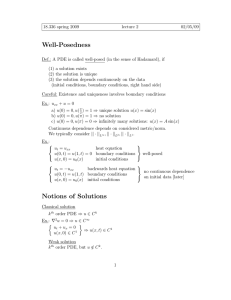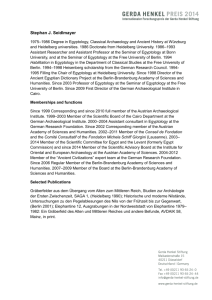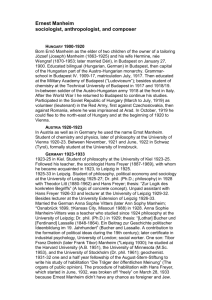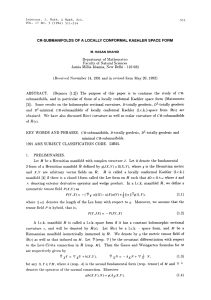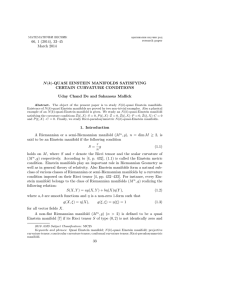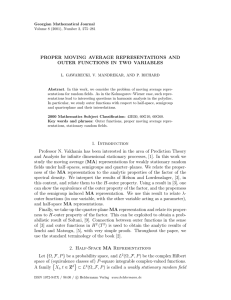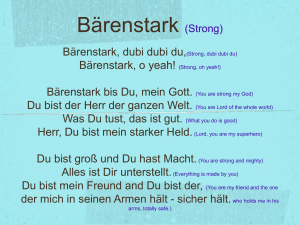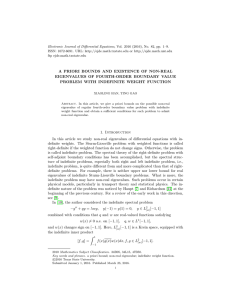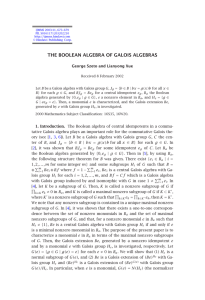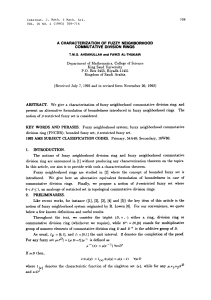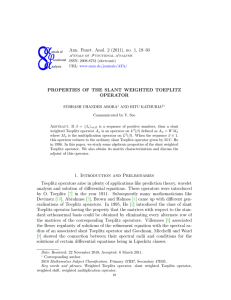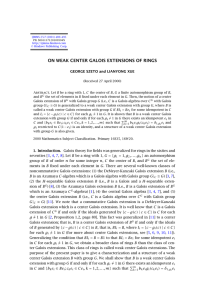Document 10440383
advertisement
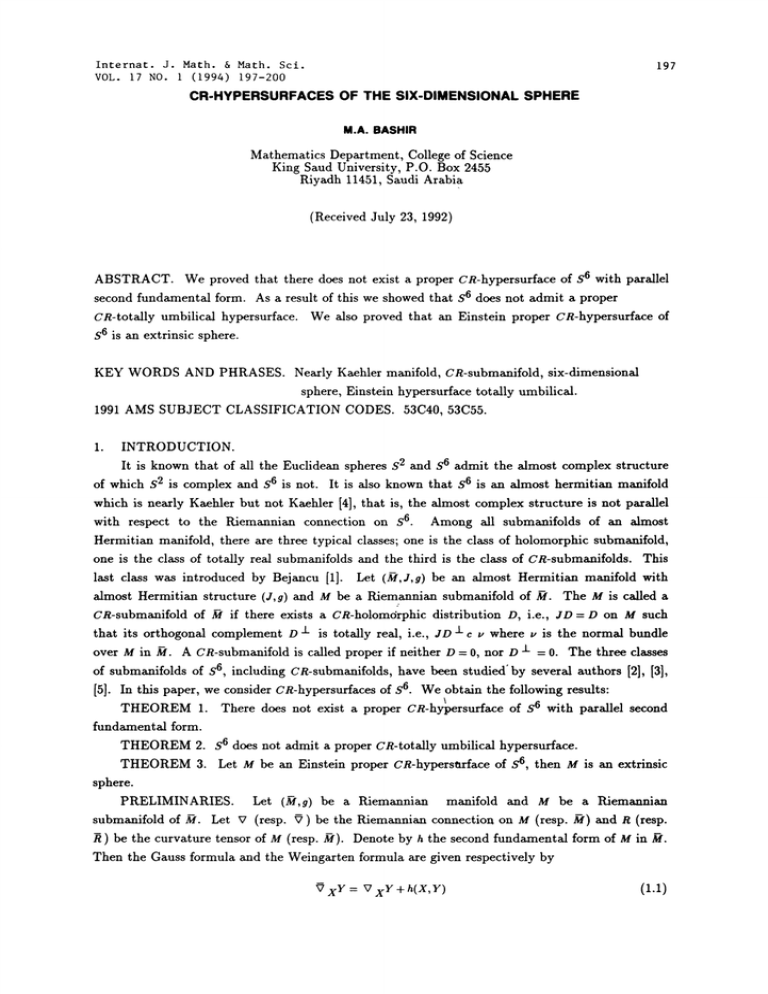
Internat. J. Math. & Math. Sci.
VOL. 17 NO.
(1994) 197-200
197
CR-HYPERSURFACES OF THE SIX-DIMENSIONAL SPHERE
M.A. BASHIR
Department, College of Science
King Saud University, P.O. Box 2455
Riyadh 11451, Saudi Arabia
Mathematics
(Received July 23, 1992)
exist a proper CR-hypersurface of S6 with parallel
second fundamental form. As a result of this we showed that S6 does not admit a proper
CR-totally umbilical hypersurface. We also proved that an Einstein proper cR-hypersurface of
S6 is an extrinsic sphere.
ABSTRACT. We proved that there does not
KEY WORDS AND PHRASES. Nearly Kaehler manifold, CR-submanifold, six-dimensional
sphere, Einstein hypersurface totally umbilical.
1991 AMS SUBJECT CLASSIFICATION CODES. 53C40, 53C55.
1.
INTRODUCTION.
It is known that of all the Euclidean spheres 82 and S6 admit the almost complex structure
of which S2 is complex and 5’6 is not. It is also known that S6 is an almost hermitian manifold
which is nearly Kaehler but not Kaehler [4], that is, the almost complex structure is not parallel
with respect to the Riemannian connection on S 6. Among all submanifolds of an almost
Hermitian manifold, there are three typical classes; one is the class of holomorphic submaifold,
one is the class of totally real submanifolds and the third is the class of CR-submanifolds. This
last class was introduced by Bejancu [1]. Let (r,j,g) be an almost Hermitian manifold with
The M is called
almost Hermitian structure (J,g) and M be a Riemannian submanifold of
CR-submanifold of r if there exists a CR-holom6rphic distribution D, i.e., JD D on M such
that its orthogonal complement D 2. is totally real, i.e., JD-Lc u where u is the normal bundle
over M in/. A CR-submanifold is called proper if neither D 0, nor D 2- 0. The three classes
of submanifolds of S6, including CR-submanifolds, have been studied’ by several authors [2], [3],
[5]. In this paper, we consider cR-hypersurfaces of S1}. We obtain the following results:
THEOREM 1. There does not exist a proper CR-hypersurface of S6 with parallel second
fundamental form.
THEOREM 2. S6 does not admit a proper CR-totally umbilical hypersurface.
THEOREM 3. Let M be an Einstein proper cR-hypersttrface of S6, then M is an extrinsic
sphere.
PRELIMINARIES. Let (r,g) be a Riemannian manifold and M be a Riemannian
Let
submanifold of
(resp. ) be the Riemannian connection on M (resp. ) and R (resp.
R be the curvature tensor of M (resp. ,). Denote by h the second fundamental form of M in
Then the Gauss formula and the Weingarten formula are given respectively by
.
.
XY
X7 X Y + h(X,Y)
(1.1)
M.A. BASHIR
198
+/-
aNX + V X u
xu
X,r
where -ANX (resp. X N) denotes the tantial part (resp. normal part) of
component ANX is related to the second fundamental form by
(avX, r ),
g(h(X, r), N)
(1.2)
;(M)
X N. The tangential
x,v (m).
The Gauss equation is given by
/(R(X, Y)Z, W)
g(R (X, Y)Z, W) + g(h(X, W),h(Y,Z))
I(h(X,Z),h(Y, W))
(1.3)
The Codazzi equation is
9((X,Y)Z,N) g(( xh)(V,g)-( yh)(X,Z),N)
where
Xh)(Y,2)=
If (,)
1,2,.
+/-
(1.4)
xh(Y,Z)-h( xY,2)-h(Y, X Z)
., is a frame field for M, then the Ricci curvature S of M is given by
S(X,Y)
R(ei, X,Y,e.i).
i=1
The submanifold M is called an Einstein manifold if $(x, Y) e9(X, Y) for some constant c and
any x,Y 6(M). M is said to be totally umbilical if h(X,Y)= (X,Y)hr where hr is the mean
curvature vector defined by fir n trace h.
M is called an extrinsic sphere if
Xhr =0 for any X (M). The CR-submanifold M is
called a CR-product submanifold if it is locally the Riemannian product of holomorphic
submanifold and a totally real submanifold. Sekigawa [6] proved that in S6 there does not exist
any CR-product submanifolds.
2. PROOF OF THE MAIN RESULTS.
PROOF OF THEOREM 1. Since the second fundamental form is parallel we have
(VwA)(V)=O or VwAV=AVwV for any V, W;(M). If V is an eigenvector of A with
corresponding eigenvalue 8, i.e., AV =/W, then from the equation Vw(AV)= A V W V we get
#VW V A V W V. This means that V w V is an eigenvector corresponding to eigenvalue #
whenever V is. If T is the eigenspace of # then w T c T.
Since M is a proper CR-hypersurface of S6, we can take {EI,JE1,E2,JE2,} as an
orthonormal frame field for TM where E1,E2 D and
D .L. Also since the normal bundle is 1dimensional we assume that the frame {E1,JE1,E2,JE2,} diagonalizes A. So let AE =alE1,
AJE
1JE1,AE2 a2E2,AJE2 2JE2 and A M. We consider the two cases for the
eigenvalues ai, i,B
1,2.
CASE 1" ai#and’i#Bforalli=l,2.
In this case we have g( V w,Ei) g( W,JEi) 0 for all W (M). This gives V W D .L,
D we get V W 0. This last equation with
i.e., the distribution D _1_ is parallel. Since v
g(,x) 0 for x q D gives X7 W X D, i.e., the distribution D is also parallel. This implies that M
is a CR-product, a contradiction, since S6 does not admit any CR-product submanifold [6].
for some o.
or
CASE 2: %o"
io
Without loss of generality let us assume that
%o" for some o. Then the space T spanned
by {Eio,} is the eigenspace of eigenvalue
%o" We then have V w T c T. In particular
"
"
.
w
CR-HYPERSURFACES OF THE SIX-DIMENSIONAL SPHERE
rE, =aEi+b for some
usin the equation EJE,
functions
a
and b. Since
we get
the help of equations (1.1) and (1.2)
g(VElo,)=O
=JE,oEiowith
that h e JD 1 we get g(
E, Eio,) O. From which we get g(
using this last equation and the fact that v
0, we get
R(Eio,)
V
199
E
Io
TEi=aEio.
6Elo)
Also
d the fact
O, i.e., 7 E,
0.
Now
E,
But V Eio=CEio+d=O since g(V Eio, Eio)=O. g(V Eio,)= -g(V ,Eio)=O. So R(Eio,)=O.
However from Gauss equation we obtain g(R(Eio,),Eio)=C +82>0 which is a contradiction.
This finishes the proof of Theorem 1.
PROOF OF THEOREM 2. Since M is totally umbilical we have h(X,Y)= g(X,Y)H for any
1
X, Y e(M).
Using this in Codazzi equation (1.4) we get g(R(X,Y)Z,N)=g(g(Y,Z)TxH
+/Since the ambient space 86 is of constant curvature we have
g(X,Z) yH, N).
+/+/g(g(Y,Z)TxH-g(X,Z)TyH, N)=O,X,Y, Ze(M ). Now for any Xe,(M), choose Y such that
g(Y,x) O and let z Y. Then the above equation gives X H O, i.e., H is parallel. Using a
frame field (Ei),l_<i<5 with E 5 in D +/- and the rest in D, one can write H =TJE 5 for some
constant 7. Also the equation h(X,Y)= g(X,Y)H gives h(Ei, Ei)= 7JE5, and h(Ei, Ej)=0 for # j.
Note that in this case
+/-
V Eih)(Ej, Ek)= V Eih(Ej, Ek)-h V
Eig(Ej, Ek)H
0
EiEj, Ek)-h(Ej, V EiEk
for all i,j.
where we have used the equation h(X,Y)= g(X,Y)H in the second equality. This means that M
has parallel second fundamental form. Then using Theorem we obtain Theorem 2.
PROOF OF THEOREM 3. Let {X,Y, JX, JY, Z} be an orthonormal frame for TM where
X, Y E D and g e D 2_. Since M is a hypersurface we know that the above frame diagonalizes A.
Therefore one can write
aJZ, h(X,X)
h(Z,Z)
JZ, h(JX, JX)
7JZ, h(Y,Y)
6JZ, h(JY, JY)
and
h(Z,X)
where
h(Z, JX)
h(Z, JY)
h(X, JX)
h(X,Y)
h(X, JY)
h(Y, JY)
0
smooth functions on M. Then using Guass equation (1.3) we get
a, 8, 7,,7 are
S(Z,Z)
h(Z,Y)
7SZ
R(X,Z,Z,X) + R(JX, Z,Z, JX) + R(Y,Z,Z,Y) + R(JY, Z,Z, JX)= 4c + a( + 7 + + 7)
Similarly
4c + (a + 7 +
S(X,X)
s(sx, sx)
S(Y, Y)
S(JY, JY)
+ 7)
4c + ( + fl +
4c + 6(a +
+7+)
4c + rl(a +
+ 6 + rl)
Since M is Einstein we have
S(Z,Z) S(X,X)
i.eo
, ,
,(Z + + + 7)
(i)
Z(, + v + + 7)
(ii)
+)
S(JX, JX)
S(Y,Y)
-r(, + Z + + ,)
(iii)
s(gY, JY)
(, + Z + "r + ,)
(iv)
constant
,(o, + Z + -r + 6)
(v)
const.
200
M.A. BASHIR
We shall show that c,,3, 3’, and
r/are
constants. From the above equations we have:
a(3’ + + r/)
8(3’ + + r/),
(, +
+ r/) v(, + + r/)
3’( + + r/)
( + + r/),
( + Z + 3’)
r/(’ + + v)
We seek all solutions for this system. One obvious solution is
a
r/=
3’
eorst.
The other
possible solutions are the following cases:
(a)
3" +
+ r/ , + + r/
In this
get
(b)
(c)
(d)
+ + r/
case we have a
c,
const,
or
3’
+ +r/= coast,
2
O
and
const.
Z considering (i) and (iv) with
So for this case , ,
$
3’,
,
r/are
we
constants.
a== and r/=3’.
Using (ii) and (v) with
we get r/= 3’ a const, or r/= 3’ -2a const., i.e., tr, /, 3’, $, r/ are constants.
a
a==3’,a++r/=,++3’=0, i.e., a=Z=3’=r/. Using (i) and (iv) with this last
const. (Note that in case a
equation we get a
=,
0, then M is
r/=
totally geodesic and hence
0).
a==3’=,a++3’=0, i.e., a==,==0. Following the note in (c) we have
a=,a++r/=a+Z+r/=a++-=0, i.e.,
r/=0.
Therefore in all cases a
3’ $ r/= const. We conclude that//= aJZ where
thus v
0 for any V (M), i.e., M is an extrinsic sphere.
a
is constant and
J-//=
REFERENCES
1.
2.
3.
BEJANCU, A., CR-submanifolds of a Kaehlerian manifold I, Proc. Amer. Math. Soc. 69
(1978), 135-142.
DILLEN, F.; VERSTRADEN, L. & VRANCKEN, L., On almost complex surfaces of the
nearly Kaehler 6-sphere II, Kodai Math. J. 10 (1978), 261-271.
EJIRI, N., Totally real submanifolds in 6-sphere, Proc. Amer. Math. Soc. 83 (1981),
759-763.
4.
5.
FUKAMI, T. & ISHIHARA, S., Almost Hermitian structure on S6, Tohoku Math. J. 7
(1955), 151-156.
GRAY, A., Almost complex submanifolds of six sphere, Proc. Amer. Math. Soc. 20 (1969),
277-279.
SEKIGAWA, K., Some CR-submanifolds in a 6-dimensional sphere, Tensor N.S. 41 (1984),
13-19.
